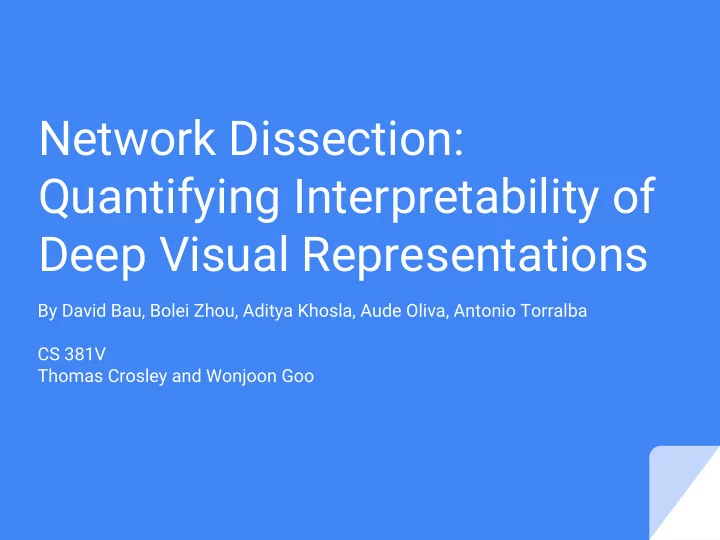

Network Dissection: Quantifying Interpretability of Deep Visual Representations By David Bau, Bolei Zhou, Aditya Khosla, Aude Oliva, Antonio Torralba CS 381V Thomas Crosley and Wonjoon Goo
Detectors
Credit: slide from the original paper
Unit Distributions ● Compute internal activations for entire dataset ● Gather distribution for each unit across dataset
Top Quantile ● Compute T k such that P(a k > T k ) = 0.005 ● T k is considered the top-quantile ● Detected regions at test time are those with a k > T k
Detector Concept ● Score of each unit is its IoU with the label ● Detectors are selected with IoU above a threshold ● Threshold is U k,c > 0.04.
Test Data ● Compute activation map a k for all k neurons in the network
Scaling Up ● Scale each unit’s activation up to the original image size ● Call this the mask-resolution S K ● Use bi-linear interpolation
Thresholding S K M K ● Now make the binary segmentation mask M k ● M k = S K > T K
Experiment: Detector Robustness ● Interest in adversarial examples ● Invariance to noise ● Composition by parts or statistics
Noisy Images + Unif[0, 1] + 5 * Unif[0, 1] + 10 * Unif[0, 1] + 100 * Unif[0, 1]
Conv3 Original + Unif[0, 1] + 5 * Unif[0, 1] + 10 * Unif[0, 1] + 100 * Unif[0, 1]
Conv4 Original + Unif[0, 1] + 5 * Unif[0, 1] + 10 * Unif[0, 1] + 100 * Unif[0, 1]
Conv5 Original + Unif[0, 1] + 5 * Unif[0, 1] + 10 * Unif[0, 1] + 100 * Unif[0, 1]
Rotated Images 10 degrees Original 45 degrees 90 degrees
conv3 Original 10 degrees 45 degrees 90 degrees
conv4 Original 10 degrees 45 degrees 90 degrees
conv5 Original 10 degrees 45 degrees 90 degrees
Rearranged Images
Rearranged Images
Rearranged Images
Conv3 Original 4x4 Patches 8x8 Patches
Conv4 Original 4x4 Patches 8x8 Patches
Conv5 Original 4x4 Patches 8x8 Patches
Axis-Aligned Interpretability
Axis-Aligned Interpretability ● Hypothesis 1: ○ A linear combination of high level units serves just same or better ○ No specialized interpretation for each unit ● Hypothesis 2: (the authors’ argument) ○ A linear combination will degrade the interpretability ○ Each unit serves for unique concept How similar is the way CNN learns to human?
Axis-Aligned Interpretability Result from the Authors Figure: from the paper ● It seems valid argument, but is it the best way to show? ● Problems ○ It depends on a rotation matrix used for test ○ A 90 degree rotation between two axis, does not affect the number of unique detectors ○ The test should be done multiple times and report the means and stds.
Experiment: Axis-Aligned Interpretability
Is it really axis aligned? Figure: From Andrew Ng’s lecture note on PCA ● Principle Component Analysis (PCA) ○ Find orthonormal vectors explaining samples the most ○ The projections to the vector u_1 have higher variance ❖ Argument: a unit itself can explain a concept ➢ Projections to unit vectors should have higher variance ➢ Principal axis (Loading) from PCA should be similar to one of the unit vectors
Our method 1. Calculate the mean and std. of each unit activation 2. Grab activations for a specific concept 3. Subtract mean and std from activations 4. Perform SVD 5. Print Loading Hypothesis 1 Hypothesis 2 The concept is interpreted with the combination The concept can be interpreted with an of elementary basis elementary basis (eg. e_502 := (0,...,0,1,0,...,0) )
(Supplementary) PCA and Singular Value Decomposition (SVD) From Cheng Li, Bingyu Wang Notes ● Optimize target: ● With Lagrange multiplier: ● The eigenvector for the highest eigenvalue becomes principal axis (loading)
PCA Results - Activations for Bird Concept ● Unit 502 stands high; concept bird is aligned to the unit ● Does Unit 502 only serve for concept Bird? ○ Yes ○ It does not stand for other concepts except bird ● Support Hypothesis 2
PCA Results - Activations for Train Concept ● No units stands out for concept train ○ Linear combination of them have better interpretability ○ Support Hypothesis 1
PCA Results - Activations for Train Concept ● No units stands out for concept train Some objects with circle and trestle? ○ Linear combination of them have interpretability
PCA Results - Activations for Train Concept ● No units stands out for concept train The sequence of square boxes? ○ Linear combination of them have interpretability
PCA Results - Activations for Train Concept ● No units stands out for concept train ○ Linear combination of them have interpretability Dog face!
Conclusion…? ● Actually, it seems mixed! ● CNN learns some human concepts naturally, but not always ○ It might highly correlated with the label we give
Other Thoughts ● What if we regularize the network to encourage its interpretability? Taxonomy-Regularized Semantic Deep Convolutional Neural Networks, ○ Wonjoon Goo, Juyong Kim, Gunhee Kim, and Sung Ju Hwang, ECCV 2016
Thanks! Any questions?
Recommend
More recommend